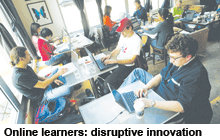Graduation rates in the US have fallen with state governments slashing funding for higher education. As a result, public universities have raised tuition fees, and many are struggling to stay afloat during the recession. But two authors working in the US higher education sector claim the academy has a bigger battle on the horizon: the “disruptive innovation” ushered in by online education.
This disruption, they say, will force down costs, lure prospective students away from traditional “core” universities, transform the way academics work, and spell the end for the traditional scholarly calendar based on face-to-face teaching. Clayton M. Christensen, the Robert and Jane Cizik professor of business administration at Harvard Business School, and Henry J. Eyring, advancement vice-president at Brigham Young University-Idaho, outline their ideas in The Innovative University: Changing the DNA of Higher Education from the Inside Out.
 “In almost every market, you can characterise the history of that industry as a set of concentric circles,” says Christensen. It is the innermost circle, representing “customers” who have a lot of money and a lot of skills the authors say, the higher education sector is currently trying to target.
“In almost every market, you can characterise the history of that industry as a set of concentric circles,” says Christensen. It is the innermost circle, representing “customers” who have a lot of money and a lot of skills the authors say, the higher education sector is currently trying to target.
Online education will bring about a shift by opening higher education to a new middle group in the concentric circles, they argue. “We use the word ‘disruptive’ not because it is a breakthrough improvement for that middle group, but because it transforms the product or service into something that is so much more affordable and simple that a whole new population can afford it and find that it is accessible to them,” says Christensen. The book asserts that until now, unlike other industries, higher education has not had a “disruptive innovation” which has driven down costs. The result has been “sustained and difficult price increases”.
Eyring points to the success of US higher education over the past century as a reason why disruptive innovation has not been seen in the sector before now. However, he argues that rising tuition fees, which are the result of smaller colleges trying to emulate the Ivy League’s wealthy and long-established institutions, present an opportunity for change. But despite the authors’ confidence in the transformative possibilities of online learning, they admit the disruptive potential will not affect all institutions equally. “Harvard could continue as it is for a very long time because demand is so high and its prestige is so high,” says Eyring. “But I don’t think it will — it’s already making some extraordinary investments in online education.”
However, even if Harvard is able to transform itself, Christensen says it is unlikely to lead the field in online learning. “Almost invariably, the (established) leaders find it impossible to lead the industry in disruption,” he says. “It’s not technology per se that keeps them in the middle, but the very fact that it is affordable and accessible makes it almost impossible for the (sector’s traditional) leaders to address.”
Eyring and Christensen suggest that universities and colleges may need to look at “efficiency measures”, such as year-round learning. The benefits of combining traditional scholarship with online innovation, the pair claim, will be a driving-down of costs, with faculty members able to serve more students. “You can have fewer face-to-face classes, with more of the work occurring online,” says Eyring.
(Excerpted and adapted from Times Higher Education)